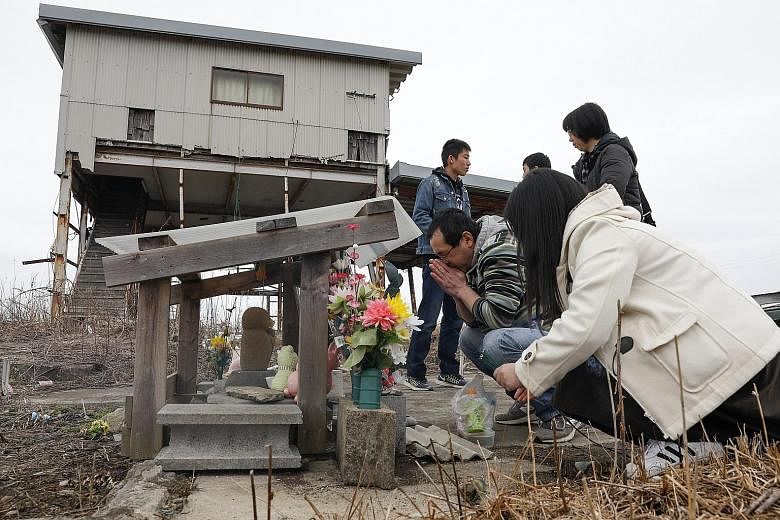TOKYO • Prime Minister Shinzo Abe led a sombre ceremony yesterday as Japan marked the seventh anniversary of a deadly earthquake, tsunami and nuclear disaster that devastated its north-eastern coast and left about 18,500 people dead or missing.
The magnitude-9 quake, which struck under the Pacific Ocean on March 11, 2011, and the resulting tsunami caused widespread damage and took the lives of thousands.
The killer tsunami also swamped the emergency power supply at the Fukushima Daiichi power plant, sending its reactors into meltdown as cooling systems failed in what was the world's worst nuclear disaster since Chernobyl in 1986.
Mr Abe, lawmakers and family members who lost their loved ones in the disaster, bowed their heads in silent prayer at a ceremony in Tokyo at 2.46 pm, the exact moment the quake struck. Japanese private broadcasters also showed images of residents in the affected areas offering a moment of silence.
"I offer my condolences to those who lost their beloved family members and friends," said Mr Abe.
Ms Hideko Igarashi, one of the three residents from the disaster-hit region who spoke at the ceremony, said Japan should "never forget what we learnt from the disaster".
The 70-year-old woman from Fukushima was hit by tsunami waves right after she began preparing to leave the area with her husband and uncle. "I grabbed a pine tree but I was hit by the tsunami... My husband got away from me and he shouted 'Hideko' three times."
She survived and was later rescued by an emergency team. "I wish I had told him to run away much earlier."
The total number of people dead or missing from the earthquake and the tsunami stood at 18,434, according to the National Police Agency.
In addition, more than 3,600 people, most of them from Fukushima, died from causes such as illness and suicide linked to the aftermath of the tragedy, government data shows.
More than 73,000 people still remain displaced, while no one is officially recorded as having died as a direct result of the catastrophe.
The government lifted evacuation orders for some areas in Iitate village and the towns of Namie, Kawamata and Tomioka last spring, except for no-go zones with high radiation levels.
The authorities are encouraging evacuees to return, but a government survey released earlier this month showed that about half of the residents of Namie and Tomioka are not willing to return.
About 12,000 who fled their homes for fear of radiation have filed dozens of lawsuits against the government and the Tokyo Electric Power Company, the operator of the stricken nuclear plant.
AGENCE FRANCE-PRESSE

